Scientific papers 2021 - Part A






Authors:
Kurt Magri, Ingrid Eftedal, Vanessa Petroni Magri, Lyubisa
Matity, Charles Paul Azzopardi, Stephen Muscat, and
Nikolai Paul Pace.
Abstract:
Decompression sickness (DCS) develops due to inert gas
bubble formation in bodily tissues and the circulation,
leading to a wide range of potentially serious clinical
manifestations. Its pathophysiology remains incompletely
understood. In this study, the authors explore changes in
the human leukocyte transcriptome in divers with DCS
compared to closely matched unaffected controls after
uneventful diving.
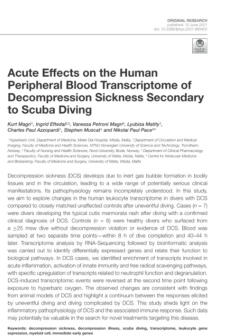

Authors:
Anna B. Marcinkowska, Natalia D. Mankowska, Jacek Kot,
Pawel J. Winklewski.
Hyperbaric oxygen therapy (HBOT) is a modality of
treatment in which patients inhale 100% oxygen inside a
hyperbaric chamber pressurised to greater than 1
atmosphere. The aim of this review is to discuss
neuropsychological findings in various neurological
disorders treated with HBOT and to open new
perspectives for therapeutic improvement.
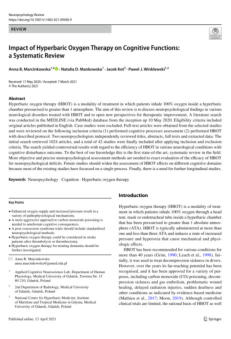

Authors:
Thijs T. Wingelaa, Leonie Bakker, Frank J. Nap, Pieter-Jan
A. M. van Ooij, Edwin L. Endert, and Rob A. van Hulst.
Intrapulmonary pathology, such as bullae or blebs, can
cause pulmonary barotrauma when diving. Many diving
courses require chest X-rays (CXR) or high-resolution
computed tomography (HRCT) to exclude asymptomatic
healthy individuals with these lesions. The ability of routine
CXRs and HRCT to assess fitness to dive has never been
evaluated.
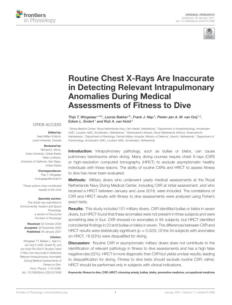

Authors:
Roxane Monnoyer, Kjersti Haugum, Jacky Lautridou,
Arnar Flatberg, Astrid Hjelde, and Ingrid Eftedal.
During commercial saturation diving, divers live and work
under hyperbaric and hyperoxic conditions. The myriads
of bacteria that live in and on the human body must
adjust to the resultant hyperbaric stress. In this study, the
authors examined the shifts in bacterial content in the oral
cavity of saturation divers, using a metagenomic approach
to determine the diversity in the composition of bacterial
phyla and genera in saliva from 23 male divers before,
during, and immediately after four weeks of commercial
heliox saturation diving to a working depth of circa 200 m
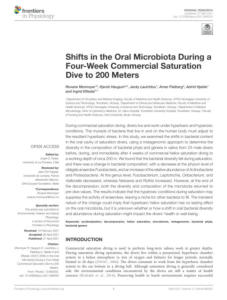

Authors:
Richard V. Lundell, Laura Tuominen,Tommi Ojanen, Kai
Parkkola, & Anne Räisänen-Sokolowski
Technical diving is very popular in Finland throughout the
year
despite diving conditions being challenging, especially
due to arctic water and poor visibility. Coldwater,
immersion, submersion, hyperoxia, as well as
psychological and physiological stress, all have an effect
on the autonomic nervous system (ANS). To evaluate
divers’ ANS responses, short-term (5 min) heart rate
variability (HRV) during dives in 2–4 degrees C water was
measured. HRV resting values were evaluated from
separate measurements before and after the dives.
Twenty-six experienced closed circuit rebreather (CCR)
divers performed an identical 45-meter decompression
dive with a non-physical task requiring concentration at
the bottom depth.
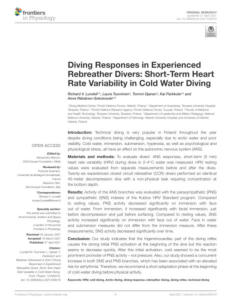

Authors:
Eric Mulder, Arne Sieber, Erika Schagatay
Deep freediving exposes humans to hypoxia and
dramatic changes in pressure. The effect of depth on gas
exchange may enhance the risk of hypoxic blackout (BO)
during the last part of the ascent. The purpose of this
study was to investigate arterial oxygen saturation (SpO 2
) and heart rate (HR) in shallow and deep freedives,
central variables, which have rarely been studied
underwater in deep freediving.


Authors:
Matteo Paganini, Giulia Mormando, Sandro Savino,
Giacomo Garetto, Giulia Tiozzo, Enrico M. Camporesi,
Fabrizio Fabris, and Gerardo Bosco
Hyperbaric chambers and underwater environments are
challenging and at risk of serious accidents. Personnel
aiming to assist patients and subjects should be
appropriately trained, and several courses have been
established all over the world. In healthcare, simulation is
an effective learning technique. However, there have
been few peer-reviewed articles published in the medical
literature describing its use in diving and hyperbaric
medicine.


Authors:
Sanjoy K. Deb, Eimear Dolan, Catherine Hambly, John R.
Speakman, Olav Eftedal, Mohammed Gulrez Zariwala,
and Ingrid Eftedal
Commercial saturation divers are exposed to unique
environmental conditions and are required to conduct
work activity underwater. Consequently, divers’
physiological status is shown to be perturbed, and
therefore, appropriate strategies and guidance are
required to manage the stress and adaptive response. This
study aimed to evaluate the daily energy expenditure
(DEE) of commercial saturation divers during a 21-day
diving operation in the North Sea.


Authors:
Kurt Magri, Ingrid Eftedal, Vanessa Petroni Magri, Lyubisa
Matity, Charles Paul Azzopardi, Stephen Muscat, and
Nikolai Paul Pace.
In this study, the authors aim to explore changes in the
human leukocyte transcriptome in divers with DCS
compared to closely matched unaffected controls after
uneventful diving. Cases (n = 7) were divers developing
the typical cutis marmorata rash after diving with a
confirmed clinical diagnosis of DCS. Controls (n = 6) were
healthy divers who surfaced from a ≥25 msw dive without
decompression violation or evidence of DCS. Blood was
sampled at two separate time points—within 8 h of dive
completion and 40–44 h later. Transcriptome analysis by
RNA-Sequencing followed by bioinformatic analysis was
carried out to identify differentially expressed genes and
relate their function to biological pathways.
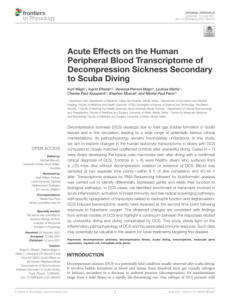

Authors
Eric Mulder, Arne Sieber, & Erika Schagatay
Deep freediving exposes humans to hypoxia and
dramatic changes in pressure. The effect of depth on the
gas exchange may enhance the risk of hypoxic blackout
(BO) during the last part of the ascent. This study
investigated arterial oxygen saturation (SpO2) and heart
rate (HR) in shallow and deep freedivers, central variables
which have rarely been studied underwater in deep
freediving.
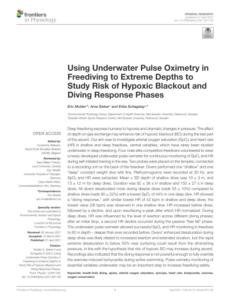

Authors:
Fabian Möller, Elena Jacobi, Uwe Hoffmann, Thomas
Muth, Jochen D. Schipke.
Oxygen-enriched air is commonly used in diving and
might affect ventilation and heart rate, but little work exists
for applied diving settings. This study hypothesized that
ventilation is decreased, especially during strenuous
underwater fin-swimming when using oxygen-enriched
air as breathing gas.
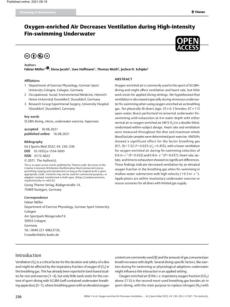

Authors: Wei-Shih Tseng, Nian-Sheng Tzeng, Kung-Hung
Lin, Nan-Chieh Huang, Man-Yuan Huang, and
Bor-Hwang Kang
Divers with a history of decompression sickness may be at
high risk for sleep problems. However, limited studies have
investigated the relationship between diving exposure and
sleep problems of occupational divers. This study
investigated the association between diving exposure and
sleep quality and quantity among male occupational
divers in southern Taiwan.
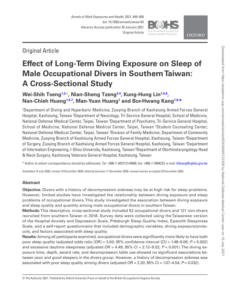

Author: Alexander Patrician, Željko Dujic, Boris Spajic, Ivan
Drviš, and Philip N. Ainslie.
Breath-hold diving involves highly integrative physiology
and extreme responses to both exercise and asphyxia
during progressive elevations in hydrostatic pressure. With
astonishing depth records exceeding 100 m, and up to
214 m on a single breath, the human capacity for deep
breath-hold diving continues to refute expectations. The
physiological challenges and responses occurring during
a deep dive highlight the coordinated interplay of
oxygen conservation, exercise economy, and
hyperbaric management. In this review, the physiology of
deep diving is portrayed as it occurs across the phases of a
dive.
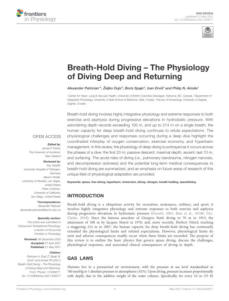

Authors:
Patrice Jissendi-Tchofo, Yassin Jdaoudi, Peter Germonpré,
Danilo Cialoni, Andrea Brizzolari, Patrick Musimu,
Costantino Balestra.
This study hypothesizes that Blood Oxygen Level
Dependent signal variations express the functional
adaptive diving response under prolonged apnea at rest.
That is a preliminary report whose results are promising for
large series of investigations.


Authors:
Xiao-Chen Bao, Yi-Qun Fang, Tao Yang, Yong-jun Sun, Jun
Ma, Ji Xu, Nan Wang, Fang-Fang Wang
The authors of this paper tested the changes in pulmonary
function of divers after 80m, 100m, and 120m heliox dive.
They found that single deep heliox diving can cause
temporary expiratory and minor airway dysfunction,
which can be recovered 24h after diving. This result
increases our knowledge of the impact of the diving
environment on the body, and corresponding preventive
measures should be taken in this regard.
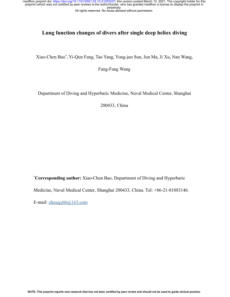

Authors:
Michael R. Kahn, Richard L. Watson, Jay T.
Thetford, Joseph Isaac Wong, and Nader Kamangar
21% of patients with severe COVID-19 sustained
barotrauma (33% of patients receiving Intermittent
mandatory ventilation (IMV), 8% of patients receiving
Non-invasive ventilation (NIV). There were no differences
between the barotrauma and non-barotrauma groups
regarding demographics, illness severity, or medications
received, nor tidal volume or average/peak airway
pressures in those receiving IMV.


Authors:
Amit Chopra, Ali Hani Al-Tarbsheh , Nidhi J. Shah, Hamid
Yaqoob, Kurt Hu, Paul J. Feustel g, Ronaldo Ortiz-Pacheco,
Kinner M. Patel, Jozef Oweis, Natalya Kozlova, Spyridon
Zouridis, Sahar Ahmad, Oleg Epelbaum, Woon H. Chong,
John T. Huggins, Biplab K. Saha i, Edward Conuel, Hau
Chieng, Jeannette Mullins, Divyansh Bajaj, Boris Shkolnik,
Rachel Vancavage, Nagendra Madisi, Marc A. Judson
The authors of this study compared mechanically
ventilated patients who developed a pneumothorax with
those who did not to determine the incidence, clinical
features, and outcomes of critically ill patients with COVID-
19 infection who developed pneumothorax.
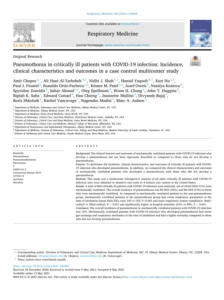

Authors:
Kiyotaka Kohshi, Hideki Tamaki, Frédéric Lemaître,
Yoshitaka Morimatsu, Petar J Denoble, Tatsuya Ishitake
Clinical characteristics of DCI in Ama divers mainly suggest
neurological involvement, especially stroke-like
cerebraleventswith sparing of the spinal cord. FemaleAma
divers achieving deep depths haver arely experienced
apanic-like neurosisfrom anxiety disorders.
Neuroradiological studies of Ama divers have shown
symptomatic
and/or asymptomatic ischaemic lesions situated in the
basal ganglia, brainstem, and deepand superfi cial
cerebral white matter, suggesting arterial insufficiency.
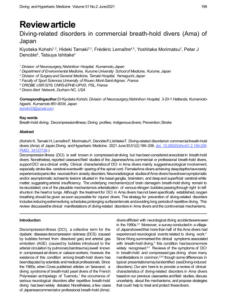

Authors: David Q. Le, Paul A. Dayton, Frauke Tillmans,
John J. Freiberger, Richard E. Moon, Petar
Denoble, Virginie Papadopoulou
The purpose of this review is to provide a technical
overview of the use of ultrasound in decompression
research, particularly Doppler ultrasound and brightness
(B)-mode ultrasound. Furthermore, the authors discuss
the strengths and limitations of these technologies. and
how new advancements are improving our ability to
understand bubble behavior post-decompression.


Authors:
Gabriel-Petric Bala, Ruxandra-Mioara Râjnoveanu,
Emanuela Tudorache, Radu Motisan, & Cristian Oancea
The goal of this review was to summarize the most
important air pollutants and their impact on the main
respiratory diseases, including chronic obstructive
pulmonary disease and asthma, lung cancer, idiopathic
pulmonary fibrosis, respiratory infections, bronchiectasis,
and tuberculosis, to reduce both short- and long-term
exposure consequences. We considered the most
important air pollutants, including sulfur dioxide, nitrogen
dioxide, carbon monoxide, volatile organic compounds,
ozone, particulate matter, and biomass smoke, and
observed their impact on pulmonary pathologies.
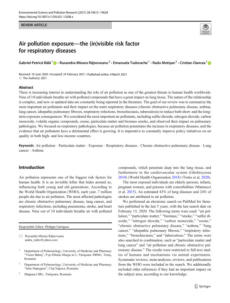

Authors: Oskari H Lindfors, Anne K Räisänen-Sokolowski,
Jari Suvilehto, Saku T Sinkkonen
Middle ear barotrauma (MEBt) is the most common
medical complication in diving, posing a serious risk to
dive safety. This was a survey study. An anonymous
electronic questionnaire was distributed to 7,060
recipients, including professional divers from the Finnish
Border Guard, the Finnish Rescue Services, and the
Finnish Heritage Agency; and recreational divers
registered as members of the Finnish Divers’ Association
and reachable by email.
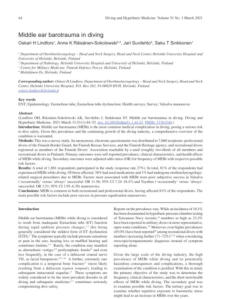

Authors
Antonio Barajas-Martínez, Geraldine Tello-Santoyo, Pablo
Berumen-Cano, Adriana Robles-Cabrera, Juan Antonio
López-Rivera, Ruben Fossion, Juan Claudio Toledo-Roy,
Alejandro Frank, Bruno Estañol, and Ana Leonor Rivera
Young men have high cardiorespiratory variability,
reflecting the balance between robustness and
adaptability to environmental and internal changes that
characterize good health. However, there are few
biomarkers of this variability. Thus, it is important to
determine the ranges for healthy men. Moreover, the
health condition of women has considerable correlation
with their menstrual cycle.
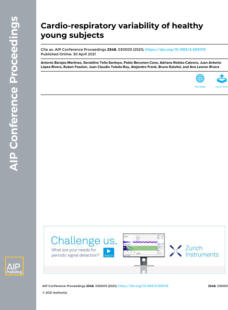

Authors: Suman Sen, Sheuli Sen
This review indicates the action of hyperbaric oxygen on
biochemical and various physiological changes in cellular
level. Narrative review covers the current indications and
contraindications of hyperbaric oxygen therapy. The
review also focuses on the therapeutic effects of
hyperbaric oxygen pretreatment and precondition in
different pathological conditions. The complications and
side effects of hyperbaric oxygen therapy are discussed.
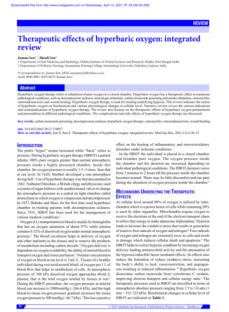

Authors:
Ethar Mohamedalfatih Fadol, Hayat Mohamed Suliman,
Bashier Osman, Safa A. Abdalla, Wadah J.A. Osman,
Elwasila M. Mohamed, Iman Hassan Abdoon.
Diabetic foot ulcers (DFUs) are a common complication of
diabetes that often leads to amputation and disability.
Despite some promising results in using hyperbaric
oxygen therapy (HBOT) for DFUs treatment, its efficacy is
still debatable. The aim of this study was to evaluate the
therapeutic outcomes of adjuvant HBOT in non-healing
DFUs treatment.
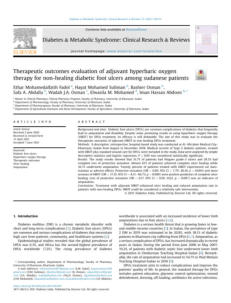

Authors: Richard Lundell, Vesa Järvinen, Harri Mäkitalo, Kai
Parkkola, Tomi Wuorimaa
There is limited knowledge of the cumulative effect of
repetitive cold-water diving on cardiac function. Single
cold dives cause some known cardiological risks, such as
malignant arrhythmia, due to a concurrent activation of
the sympathetic and parasympathetic autonomic nervous
system. A previous study from warmer water dives has
shown that successive dives cause a decrease in vagal
tone and a less responsive cardiovascular system. The aim
of this study was to evaluate changes in cardiac function
with 2D echocardiography during 4 days of diving in
near-freezing water.
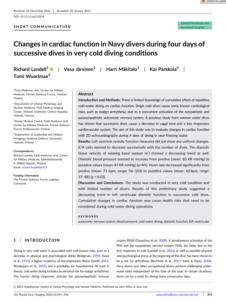

Click on the octopus
to return to the top
of the page



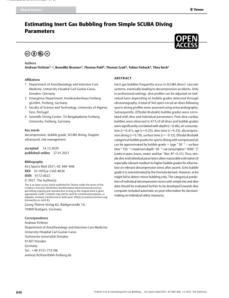
Authors: Andreas Fichtner, Benedikt Brunner, Thomas
Pohl, Thomas Grab, Tobias Fieback, Thea Koch
This study evaluated 342 open-circuit air dives using
echocardiography and the Eftedal-Brubakk bubble-grade
classification system. Post-dive cardiac bubbles were
observed in 47% of the dives, which were found to be
correlated with dive parameters and age.
The authors concluded that simple dives and individual
parameters allow for a reasonable estimation of medium
to high bubble grades, providing information on
decompression stress after ascent. Based on this
conclusion, the authors proposed a formula for estimating
bubble grades.

Authors: Gianpiero Italiano, Laura Fusini, Valentina
Mantegazza, Gloria Tamborini, Manuela Muratori,
Sarah Ghulam Ali, Marco Penso, Anna Garlaschè,
Paola Gripari and Mauro Pepi
Cardiovascular imaging is advancing quickly, with
technologies such as three-dimensional echocardiography
improving heart structure analysis. New software such as
transillumination offers detailed descriptions of valve
lesions, crucial for severity grading. In addition, machine
learning algorithms now provide fast and accurate
chamber quantification, essential for assessing left
ventricular function and guiding clinical decisions. This
review highlights these innovations in echocardiography,
offering deeper insights into heart diseases.
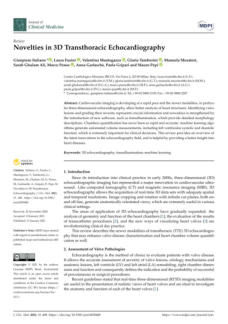

Author: Jan Risberg
This systematic review presents the results of a literature
search for studies reporting the incidence of DCS, venous
gas embolism (VGE), or subjective health reports after
multi-day hyperbaric exposure in humans and
experimental animals. The results suggest that multi-day
hyperbaric exposure is likely to have an acclimatizing effect
and protect against DCS. However, the mechanisms
causing acclimatization, the extent of protection, and the
optimal procedure for acclimatization have not been
adequately investigated.
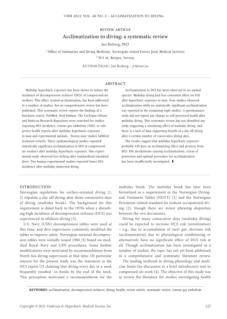

Author: arosław Krzyzak, Krzysztof Korzeniewski
New and active divers, whether recreational or
professional, are required to have a fitness to dive
certificate. This certificate ensures that there are no
medical reasons preventing someone from diving.
Evaluating health and approving diving under hyperbaric
conditions is often the responsibility of a diving instructor,
underwater work manager, or physician. Legal standards
for these certificates vary between recreational and
occupational divers.
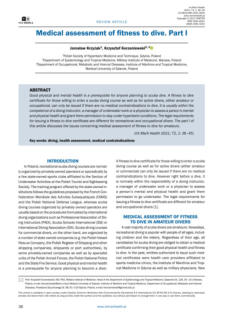

Click here



Authors: Danilo Cialoni, Andrea Brizzolari, Michele Samaja,
Gerardo Bosco, Matteo Paganini, Massimo Pieri,
Valentina Lancellotti, & Alessandro Marroni
This study investigates the physiological responses of
expert breath-hold divers to repetitive dives. It specifically
measures changes in nitrate and nitrite (NOx)
concentration, total antioxidant capacity (TAC), and lipid
peroxidation (TBARS) in blood plasma before, during, and
after the dives. The results indicate significant changes in
NOx and TAC levels at the bottom of the dive, which
return to normal shortly after surfacing, while TBARS levels
remain unchanged throughout the protocol.
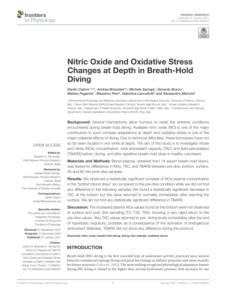

Authors: Kirsi O. Lorentz, Bianca Casa
This study assesses the prevalence of External Auditory
Exostoses (EAEs) in a Chalcolithic skeletal assemblage from
Souskiou-Laona, southwestern Cyprus. It aims to
understand human-environment interactions, activity
patterns, and behavioral differences between sexes based
on the presence of EAEs linked to repetitive aquatic
activities. The findings suggest that both males and
females participated in these activities, with varying
prevalence rates, and these differences may reflect
increasing specialization and social complexity during the
Chalcolithic period.
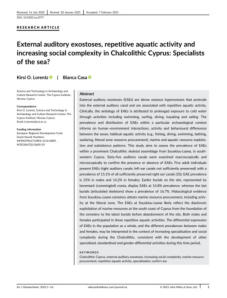

Authors: Cassondra L. Williams, and Paul J. Ponganis
This document provides a comprehensive review of the
advancements and current state of research in the field of
diving physiology of marine mammals and birds. It outlines
the historical context, key developments, and
technological advancements that have facilitated field
studies, particularly through biologging. It also highlights
significant research findings in areas such as heart rate,
blood flow, body temperature, and oxygen store
management during diving. Additionally, it discusses the
challenges and future directions for research in this field.
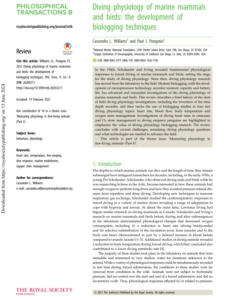

Authors: Julien D. Periard, Thijs M. H. Eijsvogels, and Hein
A. M. Daanen
This paper reviews how the human body responds to
exercise under heat stress and discusses countermeasures
to enhance aerobic performance. The authors describe
fundamental concepts and physiological processes related
to thermoregulation and fluid balance, methods to
determine thermal strain and hydration status, and the
impact of heat stress on human performance. They also
explore strategies to mitigate the effects of hyperthermia
and hypohydration, such as heat acclimation, cooling
strategies, and hyperhydration, while summarizing
contemporary controversies and suggesting future
research directions.
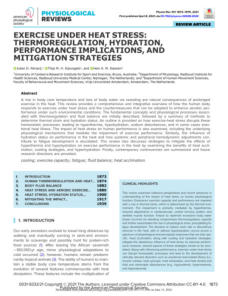

Authors:
Jianping Liu, Miaomiao Wu, Run Zhang, Zhi Ping Xu
This document aims to comprehensively review oxygen-
derived free radicals (ODFRs), their biological significance,
and the development of responsive nanoprobes for their
detection and bioimaging. It introduces the production
and biological importance of ODFRs, summarizes the
development of nanoprobes for detecting and imaging
superoxide anion and hydroxyl radicals, discusses the
specific oxidation mechanisms of these radicals, highlights
challenges, and proposes future research directions in this
field.


Authors: Yang Saeng Park, John R. Claybaugh, Keizo
Shiraki, and Motohiko Mohri
This study explains the physiological changes in urine flow
and solute excretion that occur during mixed-gas
saturation diving under hyperbaric conditions. It describes
the mechanisms behind increased diuresis, changes in
urine osmolality, and the excretion of various solutes such
as urea, potassium (K+), sodium (Na+), calcium (Ca2+),
and inorganic phosphate (Pi). It also discusses the roles of
hormones like antidiuretic hormone (ADH) and
aldosterone in these processes and highlights the need
for further research to understand the mechanisms of
impaired solute transport in the proximal tubule under
these conditions.


Authors: Fang Liang, Nan Kang, Pinpin, Xuehua Liu, Ge Li,
Jing Yang
This study investigates the effectiveness of hyperbaric
oxygen therapy (HBOT) in promoting neural functional
recovery after traumatic brain injury (TBI) by encouraging
the polarization of microglia (MG) from the pro-
inflammatory M1 phenotype to the anti-inflammatory M2
phenotype. The authors compare the expression levels of
specific biomarkers associated with M1 and M2 microglia
in both control and experimental animal models subjected
to HBOT. They conclude that HBOT can suppress pro-
inflammatory markers and enhance anti-inflammatory
markers, suggesting its potential therapeutic benefits in
managing TBI.
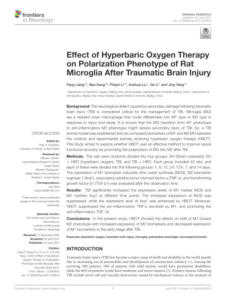




Authors: Krzysztof Dziewiatowski, Romuald Olszanski, Piotr
Siermontowski
This document describes the case of a Polish Navy Dive
Medical Officer who experienced decompression illness
(DCI) symptoms 20 years ago and was later diagnosed
with a right-to-left shunt (RLS) across a patent foramen
ovale (PFO), suggesting that this undiagnosed condition
may have contributed to the initial DCI incident. The
authors argue for the development of standards for initial
PFO screening in certain groups of divers to enhance
diving safety, recommending the use of contrast-
enhanced transcranial Doppler ultrasound for RLS
screening and the use of multi-compartment chambers for
recompression treatment.
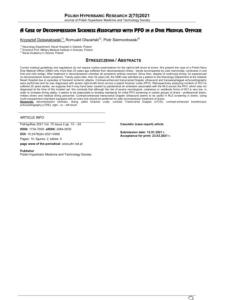

Authors: Ran Arieli
This document describes findings related to the role of
lung surfactants, particularly
dipalmitoylphosphatidylcholine (DPPC), in the formation
of gas micronuclei that can lead to decompression illness
(DCI) in divers. It discusses the mechanisms by which
DPPC leaks into the bloodstream and forms active
hydrophobic spots (AHS) that contribute to bubble
formation during decompression and explores
adaptations in deep-diving marine mammals, such as the
elephant seal, which have evolved to reduce the risk of
DCI by altering the composition of their lung surfactants.
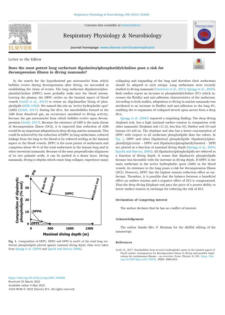



07 - Predicting the effect of decompression sickness on survival
following submarine tower escape
Authors: Geoff A.M. Loveman, & Joel J.E. Edney
The purpose of the present study was the development of
a methodology for translating predicted rates of
decompression sickness (DCS), following tower escape
from a sunken submarine, into
predicted probability of survival, a more useful statistic for
making operational decisions.
According to the authors’ knowledge, this study
represents the first attempt to quantify the effect of
different DCS symptoms on the probability of survival in
submarine tower escape.
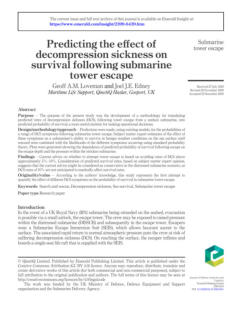



23 - The Chemistry of Reactive Oxygen Species (ROS) Revisited:
Outlining Their Role in Biological Macromolecules (DNA, Lipids
and Proteins) and Induced Pathologies

Author: Celia Andrés Juan, José Manuel Pérez de la
Lastra, Francisco J. Plou, and Eduardo Pérez-
Lebeña
Living species constantly face reactive oxidants from
outside sources and those made inside their bodies. There
is much research on reactive oxygen species (ROS), their
production, effects, and roles in cellular processes. Cells
generate ROS normally, but excess levels can cause
oxidative stress and disease. Oxidative stress happens
when there's a mismatch between radical species
production and antioxidant defenses, damaging lipids,
proteins, and DNA. This review explores the chemical
reactions of ROS and oxidative stress..
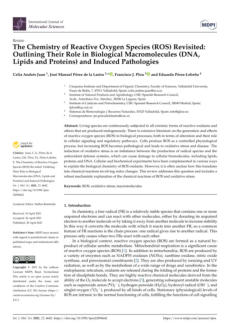



24 - Oxygen-derived free radicals: Production, biological importance,
bioimaging, and analytical detection with responsive
luminescent nanoprobes.

Author: Jianping Liu, Miaomiao Wu, Run Zhang, Zhi
Ping Xu
Oxygen-derived free radicals (ODFRs) are reactive
intermediates formed in living organisms during biological
processes. Superoxide anion and hydroxyl radicals are
highly reactive and can damage biomolecules. Elevated
levels of these radicals are linked to diseases like
neurodegenerative disorders and cancers. This review
covers the production of ODFRs, their role in diseases, and
responsive nanoprobes developed for detecting them. It
also discusses challenges and future research directions.
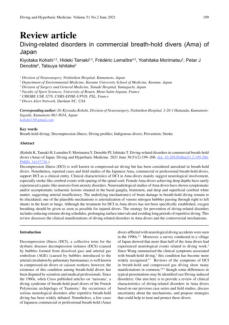



44 - Diving-related disorders in commercial breath-hold divers (Ama)
of Japan
Author: Kiyotaka Kohshi, Hideki Tamaki, Frédéric
Lemaître, Yoshitaka Morimatsu, Petar J Denoble,
Tatsuya Ishitake
Decompression illness (DCI) is recognized in compressed-
air diving and also reported in breath-hold divers like the
Japanese Ama. It often shows neurological symptoms,
particularly stroke-like events. Treatment with oxygen is
recommended, and prevention strategies include
reducing extreme diving.
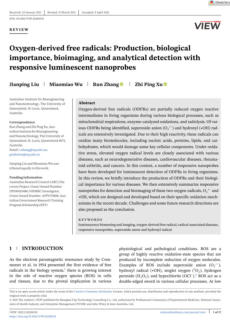



02 - Dopamine-dependent biphasic behaviour under ‘ deep diving ’
conditions in Caenorhabditis elegans.
Authors: Inbar Kirshenboim, Ben Aviner, Eyal Itskovits,
Alon Zaslave, and Limor Broday
Underwater divers face neurological risks from increased
pressure, particularly due to the effects of inert gases like
helium and nitrogen, leading to nitrogen narcosis. This
study explored the behavior of the soil nematode
Caenorhabditis elegans under scuba diving conditions. By
examining wild-type and dopamine pathway mutant
nematodes at various pressures and gas compositions,
the research found that speed changes in response to
pressure depended on dopamine levels. Dopamine-
deficient mutants did not show this response, indicating
the role of dopamine in high-pressure reactions. C.
elegans is identified as a valuable model for studying
nitrogen toxicity mechanisms.
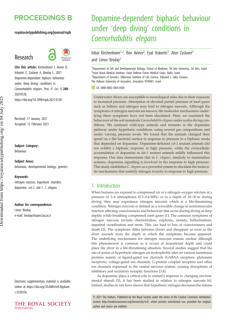



05 - Case Studies in Physiology: Breath-hold diving beyond 100
meters - cardiopulmonary responses in world-champion divers
Author: Alexander Patrician, Christopher Gasho, Boris
Spajic, Hannah G. Caldwell, Darija Bakovic -
Kramaric, Otto Barak, Ivan Drvis , Zeljko Dujic,
and Philip N. Ainslie
This case study examines two world-champion breath-
hold divers' physiological responses to deep dives of 102
m and 117 m. The divers showed impressive
management of stress during extreme hydrostatic
pressures. Pulmonary function assessments revealed
impaired gas exchange efficiency immediately post-dive,
but recovery occurred within hours. Both divers
experienced transient issues like hemoptysis and nitrogen
narcosis, highlighting their extraordinary apneic
performance under severe physiological conditions.
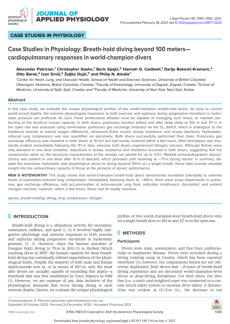



13 - Rapid ping-pong eye deviation following a recovery from
carbon dioxide narcosis.
Author: Shuichiro Neshige, Ohno Narumi, Shiro Aoki,
Hirofumi Maruyama
A 70-year-old woman with a history of panic disorder
was admitted to the emergency room due to carbon
dioxide narcosis due to atelectasis after lung cancer
lobectomy. After mechanical ventilation, she improved
consciousness and reduced responsiveness to the
environment. Neurological tests showed normal motor
function but she did not move voluntarily. Despite
breathing, she remained ventilator-dependent. The only
neurological abnormality was rapid 'ping-pong' eye
deviations, which disappeared when she was relaxed.
She was diagnosed with catatonia and functional
saccadic oculomotor disturbance
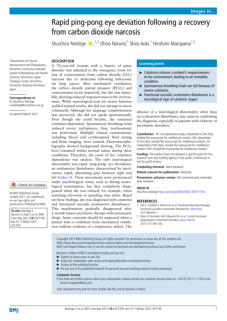



22 - Reply: Commentary on using critical flicker fusion frequency to
measure gas narcosis
Author: Xavier CE Vrijdag, Hanna van Waart, Jamie W
Sleigh, Simon J Mitchell
Research has shown that many gases that could cause a
narcotic effect due to their lipid solubility do not actually
do so because they do not fit receptor sites. Dopamine
changes are just one of many pathways affected by
oxygen around seizures, but these pathways are not
related to narcotic effects. Oxygen may increase NMDA-
receptor activity, while gases like nitrous oxide and
ketamine inhibit this receptor. Thus, oxygen's narcotic
effect seems unlikely. The study concludes that critical
flicker fusion frequency (CFFF) is not a useful measure for
monitoring gas narcosis due to its sensitivity to
confounding factors.
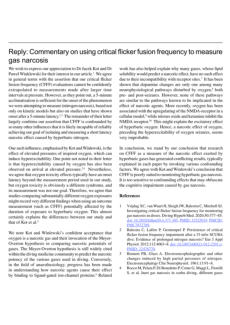



42- Commentary on using critical flicker fusion frequency to
measure gas narcosis

Authors: Jacek Kot, Pawel J Winklewski
This paper discusses the use of critical flicker fusion
frequency (CFFF) for monitoring gas narcosis in divers.
However, the authors argue that the method has
limitations, such as a five-minute acclimatization period,
which may not capture other mechanisms influencing
gas narcosis. They also note that oxygen seizures rarely
occur before 20 minutes of breathing oxygen, and that
the narcotic effect of oxygen is 3 to 4 times more potent
than nitrogen. Despite these limitations, the CFFF remains
a recognized method for assessing neuronal excitability
influencing attention and alertness.




43 - Fatalities involving divers using surface-supplied breathing
apparatus in Australia, 1965 to 2019
Author: John Lippmann
This study identifies characteristics and diving practices of
victims of fatal surface-supplied breathing apparatus
(SSBA) incidents in Australia from 1965 to 2019. The
majority were young, healthy males, with 50%
undertaking work-related diving and 37% being
recreational diving. Equipment issues, mainly compressor-
related, were the main contributor in 48% of incidents
and triggers in 24%. Preventable surface-supplied diving
deaths still occur in both occupational and recreational
diving, often due to poor equipment maintenance and
oversight. Improved education and regulatory oversight
could help control the increase in health-related incidents
in older participants.












